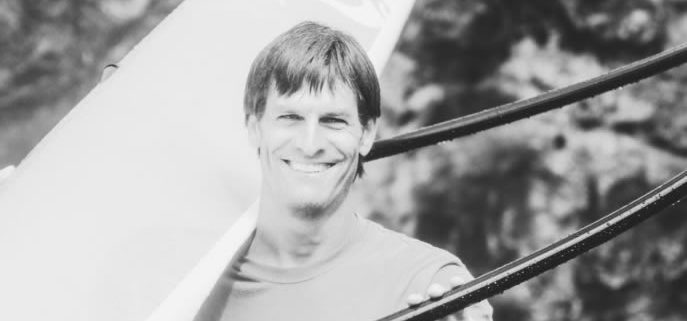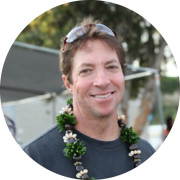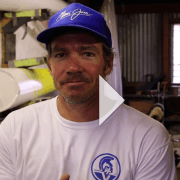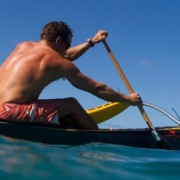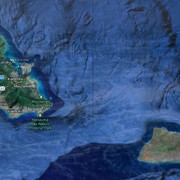Interview with Mike Giblin of Ozone
Mike Giblin Interview
By Naim Ferguson
Ozone was founded by canoe designer Mike Giblin. Based in Maui, the mecca of ocean sports and home to a strong paddling community. The journey from made-on-Maui hand-layup canoes to factory single piece pre-preg carbon canoes is one that has tested and shaped Mike and his company into what they are today.
I rode along with Mike as he ran errands on Maui to ask him questions about the company and his experience.
- Q) So let’s start in the beginning. How did you end up in Maui?
I spent a few months here after college, before starting work in NYC. I think a lot of paddlers can understand the pull of the ocean and the islands. I spent a couple of years resisting that pull. Sometimes it’s better just to give in and follow your heart.
- Q) How did you get introduced to canoe paddling?
A friend, Lindsey Richman, was coaching Novice B at Hawaiian said “Brah, you should paddle!”. Dave and I both joined and recruited the rest of our friends to paddle.
- Q) How long did it take before you began making canoes?
Dave Ward and I had started Maui Fiberglass in the garage. We built anything we could get paid for – from cattle troughs and fish boxes to water tanks for HC&S. The idea was to get experience with fiberglass any way possible.
- Q) Ok, you’re running Maui Fiberglass and now you’re paddling novice B, how long did it take before you were asked to make a canoe?
Not long. Dianna Ho, president of the club, shortly thereafter asked if I could build an OC6 for the club. “I need this canoe in 30 days” she said, Dave and I looked at each other and said “How much we talking here?” We built the molds and the first canoe in an open shed with a dirt floor in a month. Things have changed a lot since then.
- Q) At what point did OC1 come into the picture?
By strange coincidence, Daniel Waadt moved into the downstairs unit of the house we were renting. He was studying Naval architecture and stashed the plug for 20’ catamaran he was working on under the stairs. Crazy guy, but fun to work with. We collaborated on a couple of powerboats. Eventually, he moved to Oahu and designed an OC1, the Makani. Great boat, way before its time, but he had no ties to the paddling world and couldn’t sell them. So we bought the molds from him. They arrived at YB on a Tuesday. We finished the first one in time for a race that Saturday.
- Q) That’s quick. Who raced the canoe?
We showed up to the beach and my coach Lindsey turned to me and said I should race. I’m like, “What? No.” I’d been on a one man once for about 5 minutes.. Lindsey said “only difference on a one man vs six man, you have to stay smooth and you can’t bounce the boat around”. I reluctantly paddled up next to Mark Clooney, who was the fastest canoe paddler on Maui at the time. Someone, probably Ricky Balidoy, said ‘Hey Clooney, give us chance!”, Mark pointed at me and said “it’s this guy you should worry about”. Again, I’m like “what?” The field jumped off the start and left me in their wake, but I put my head down and just paddled as hard as I could. The canoe was bouncing all around and I was doing everything wrong, but I was gaining. I knew if I could smooth it out I would pass him. I did, and won the race. Should have quit paddling right then and there – best day ever.
When I got back to the beach people were lining up to ask about the canoe, and how to get one. We took orders for eleven canoes that day and never looked back.
- Q) So you establish yourself on Maui, how soon after that are you guys building canoes and making a name for yourself on the international scene?
We built canoes and paddled a lot. The lifestyle was great. Building canoes is really gratifying. But as time went on, we couldn’t get past working for wages. Growing the business meant more paperwork, more taxes and more stress. We were stuck.
Dave Ward decided to go back to business school, and I started thinking about how to move forward.
- Q) I sense this is where things started to evolve for you. Did you start looking overseas now? How did that take place?
A friend of mine, Kai Hopf, was the sail designer for North Sails. North had their production in Sri Lanka and he offered to help me set something up in Columbo. So I cut up some molds, wrapped them in cardboard, checked them as oversized luggage, and flew to Sri Lanka.
The whole enterprise in Sri Lanka was pretty short-lived, but a lot of good came from it. Sri Lanka was in the middle of a 25-year long civil war so it was nearly impossible to get things in a hurry. Pretty quick you learn that you gotta be able to get supplies.
I also got my first look at carbon prepreg in Sri Lanka. Bernie Brandstatter, who was running North’s production introduced me to John Hoboken. He ran a company making carbon fiber tennis and badminton racquets out of prepreg. John gave me access to every detail of their production and patiently answered thousands of questions. I realized really quickly that carbon prepreg canoes was the endgame.
They were shutting down the factory and John was going to run things in Malaysia and suggested that I bring the canoe business there, which I did, later.
- Q) When did you start thinking about improving designs and building the Hurricane?
Back on Maui, Wendy was working with North Sails as a seamstress making prototype sails. They were making 2 or 3 prototypes a week and testing them all. Kai Hopf did the designs on the computer, and she plotted them out with a 2-axis plotter onto sailcloth, then stitched them together ready for the team riders to test the next day.
I couldn’t stop thinking about how great it would be to be able to prototype canoes the way they did sails. Of course, canoes would be more difficult, but I built a 3-axis CNC router in an old Matson shipping container with parts from catalogs and some steel I scavenged from the abandoned overhead hoist that was in the shop. It worked surprisingly well. I made a bunch of prototypes refining along the way. The result was the Hurricane.
- Q) Did you build the Hurricane in Maui or overseas?
After Sri Lanka tanked I was back in Survival Mode. While developing the Hurricane I had bills to pay so we made a bunch of fiberglass whales and a really big sailing canoe for Mike Muller. After making a few Hurricanes on Maui I sent the molds to John Hoboken In Malaysia. Matt Fullard-Leo, who had been working with me on Maui building the prototypes, stepped in to help make Malaysia happen. We alternated three-month watches at the factory. We had our first real taste of success with the Hurricane. Jim and John Foti endorsed the canoe, and helped us connect with people like Chris Maynard in Australia and Tim Dougherty in California.
But the quality wasn’t improving and we were struggling to keep it up. Matt tapped out, and I’m at another decision point.
By now I had a hard learned lesson that quality comes from quality people. The turnover of the staff in Malaysia was too high, and it wasn’t going to change. It was time to look elsewhere.
China was the center for manufacturing by this time, it had opened up to the west and the supply chain was off the hook. I had some reservations, but I knew that moving to China would improve the product quality and accessibility. We would be in the epicenter.
I got to work learning Chinese and lived in the factory dorm, overseeing every aspect of production and training the staff. Things really accelerated. Once in the new facility we started new techniques and methods in construction, shipped in two autoclaves from the US, and I became focused on quality at scale.
And damn if it didn’t happen again. Just when things are really rolling the fan got hit, hard. The owner of the company that I was working with figured he wanted to take over the canoe business. So I told him to stick it and went to a hotel and cried. No, I didn’t, but I should have. Instead I called Wendy, who was near term with Keala, and started discussing what to do next.
China had recently changed the rules regarding foreign ownership and it was now possible to set up a WOFE (Wholly-Owned Foreign Enterprise). Basically, I could set up my own business in China, without a partner, and run things my way.
I had come to love China as a place to work. The pace is fantastic. The whole country was making up a fifty year deficit in a decade. For the first time I felt like I was driving a Mech, like Sigorney Weaver in Alien 2 or 3 or whatever. I commanded legions. Ok, that’s too much, but you get the idea. I could leverage my canoe builder skills into something much bigger. Much like I had found a home in Maui, Ozone found it’s place in Weihai.
Weihai was a fishing village for all but about 30 of the last 1500 years. With a strong heritage in fishing, it became the center of carbon fishing rod production as China’s manufacturing grew. Leading the way meant there were several big-time carbon prepreg suppliers. I followed the prepreg there, and being by the ocean made being away from Maui easier.
We’ve been there for over 12 years now. It’s easy to remember because I started the company there the same year Keala, my daughter was born. After moving the shop or production 10 times from 1991 to 2005, ten times in fourteen years, twelve years is a long time. It’s been great.
A lot of the first people that we hired when we started are still there. That’s key.
We’ve also had a string of capable people managing the factory. George Dralus got everything up and rolling. George rode his bike from England to Hong Kong. Bernie Brandstatter came over from North Sails and ran the company for a few years. Brian Dalbey is running things now, and has precisely the unlikely skill set required to run a canoe factory abroad. Brian has really done a great job.
- Q) So when do Kai Bartlett and Johnny Puakea come on board?
Kai Bartlett threw in with us when I set up the factory, and his designs have been the backbone of our sales as the Hurricane and Tempest got tired. A good designer has got to be all in. I think that’s his real strength. The guy is 100% into paddling. He loves the sport.
Johnny came on board over a beer at Ale Hale in Kahului. The timing was perfect. The Pueo had been a big success. Johnny had already started work on the Ehukai, and we had just worked out the kinks of one-piece construction developing the Storm. It was magic. Things just lined up. Brian was hitting his stride in the factory. The OIS was working. Wendy was on top of customer service. Through all the years and all of the iterations I’ve always been a dissatisfied with some detail. Not this time. We were also in the final stages of setting up production for unlimited OC6 canoes, and the Malolo just plugged right in.
Kai probably saw us turn a corner and began paddling the Ozone-built Pro Model Kai Wa’a canoes, and putting his team riders on them as well. I’ve been trying for years to get him out of the shop. We’re all better off with Kai mentoring others through clinics and camps, racing and just being Kai Bartlett.
- Q) Going back in time what advice would you give your younger self?
Ha, funny question. If I could go back in time, knowing what I know now, I’d probably not offer advice. It was a long hard road and time away from family. If I knew the trials I would face I probably would have given up. I think that it’s through the pain and struggle that you ultimately acquire the skills to succeed.
- Q) Do you ever think about bringing production back to Hawaii or the US?
I’d love to bring it back to Maui, but it’s a fantasy right now. We would have to take either a huge step backwards, or a huge step forward. It is simply too expensive to do what we do in Hawaii. We are just beginning to investigate robotics, and how we can apply them to our processes. One day we could build canoes in a more automated environment, but not yet.
While our roots are in Hawaii, our goal is to make boats for everyone. While Hawaii is our home, we can serve everyone better from Weihai.
- Q) Where do you see the sport growing now?
When the unlimited canoes started happening on the Big Island, I thought ‘I want in’. It brought new life and possibilities. Unlimited canoes now are just a glimpse of what they might be in a decade. Even in their current form they are a more fun to paddle. I want to help follow that path..
We have traditions that need to be honored. I agree with that 100%. Seeking a balance seems the best way forward. Hold on to the culture, move it forward. I understand that there are some who are strongly opposed to unlimited canoes. I think that words on paper defining our sport have been mistaken for the essence of outrigger, I see a sleek Hawaiian unlimited canoe gliding down an open ocean swell as the essence. I think it is that feeling, and the culture that created it that needs to be honored. That’s it, not a table of waterline measurements.
I could go on and on retelling what people have told me the unlimited canoes have done for them, their crew or their club. It’s really good.
- Q) Over the recent years we have seen new canoes and designs coming from Ozone, what are your goals as a company now?
In the past, it was easy to get consumed by the minutia and wondering if we would make payroll etc. It can be easy to get caught up in this part of the business and lose sight of the customer experience. We’re putting more energy into the little things that make paddling fun.
The mantra is to hold on to the core of what we do – to keep refining and improving and help people enjoy their time on the water.
Personally, I’d like to get back to “We build canoes and paddle a lot.” The lifestyle was great.

